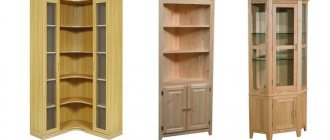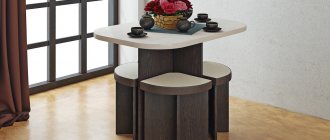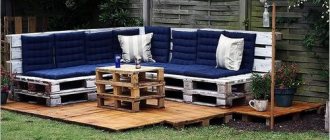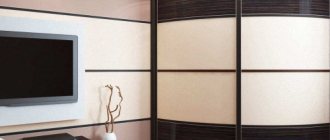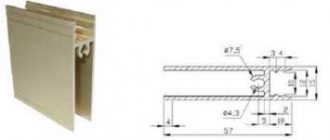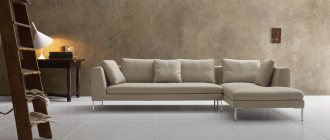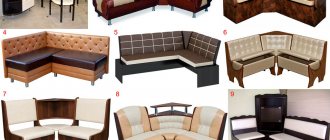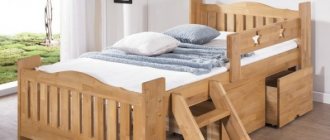Even in a spacious house or apartment you have to think about the rational use of space - every year the number of things increases. What can we say about small-sized apartments? Every centimeter counts here. One way to make optimal use of space is a corner wardrobe. This type of furniture allows you to occupy corners that are rarely used in general - it is difficult to install something there. Next, we’ll talk about what they are and how to plan the “filling” correctly.
Structure, types, sizes
The corner wardrobe can be built-in or cabinet. In built-in ones, room structures are used as walls, floors and ceilings. A façade with sliding doors is attached to them. That is, this design turns out to be stationary - the guides are attached to the walls, floor and ceiling. The advantage of this type of corner cabinets is its cost-effectiveness, the disadvantage is the impossibility of portability. Another important point: the walls, floor and ceiling must be level, otherwise the structure will be skewed, which will negatively affect the operation of the sliding doors.
The cabinet corner wardrobe has its own walls, floor and ceiling
Cabinet corner wardrobes are full-fledged furniture with walls, floor and ceiling. They differ from a regular wardrobe in the presence of sliding doors and in the fact that in height they usually occupy the entire space up to the ceiling. They are delivered from the factory or workshop disassembled and assembled locally, as they have such dimensions that they simply will not fit through the doors.
Types by structure
The shape of corner wardrobes can be of several types:
- L-shaped. The closet occupies two adjacent walls and the corner between them.
If you occupy two adjacent walls under a corner wardrobe, a lot of things will fit
Diagonal with a cross-section in the form of a triangle
Trapezoidal - asymmetrical models
Five-walled - more convenient to use the internal space
To make the difference in structure more clear, it is better to look at all models in a graphical representation (pictured below).
Types of corner wardrobes
If we talk about ease of use, then the best option is L-shaped. Normally, you can assemble the contents in a five-wall and trapezoidal wardrobe. The most inconvenient, of course, is the triangular one. It will have triangular shelves on both sides, which are not very spacious. At the same time, the middle will be empty, since the filling of the cabinet is located along the walls. The same can be said about the five-walled room, with the only difference being that there are no triangular shelves here.
What material
Corner and any other wardrobes are made from the same materials as traditional furniture - wood, MDF and chipboard. Wood is almost never used, since it is too expensive and heavy, and its decorative properties cannot be advantageously presented in this design. Laminated chipboard is much more often used. It is more affordable in price, and also has many color options. It can be an imitation of wood, rattan, etc., or it can be a smoothly painted or textured plain, matte or glossy surface. There are also films with different types of designs - graphic and floral. All of them can be used for laminating chipboard.
Any of the designs can be made with elements of radial technology - with rounded corners. Such sliding wardrobes are made from MDF, the manufacturing technology of which allows the production of rounded shapes. MDF is also laminated and there are no fewer color options.
Corner L-shaped wardrobe with radial elements
As you can see in the photo, near the entrance and in the middle part the corners are not sharp, but rounded. Firstly, it looks beautiful, and secondly, it is safer - there are no sharp edges on which you can seriously hurt yourself.
Dimensions
The easiest way is usually to decide on the height - right up to the ceiling or a couple of centimeters lower. All other parameters depend on the room in which you plan to install a corner wardrobe and the available space. We can probably say about the minimum sizes:
- If the cabinet is diagonal with a triangular cross-section, then the minimum length of the sides at the right angle is 120 cm. The volume will be very small, although they can also make walls with a length of 100 cm or even less.
- If one of the walls is longer (120 cm and 80 cm, for example), it is worth considering the option of a trapezoidal section. On the side that is longer, a partition is placed, the depth of which is about 40-45 cm, and a straight line is drawn from it to the short side.
“Serial” models start from this size, but there are also “small” ones - from 80 cm on at least one side
In a small room, the best choice is an L-shaped design. It is the least massive and leaves more space free. To visually assess this, draw all suitable types of cabinets on the floor plan. Then you can calculate the remaining free space.
A few words about the depth of wardrobes. There are two standard options - 45 cm and 60 cm, the minimum depth is 40 cm. With a width of 60 cm or more, a regular crossbar or pantograph is installed under clothes on hangers in the closet (so that the entire height to the ceiling can be used). Smaller models require a special rod that allows you to place hangers parallel to the door, since the hangers have a standard width of 55 cm and simply do not fit.
Filling corner cabinets
Like any sliding wardrobe, the corner wardrobe has a certain set of shelves, drawers, baskets and sections for hangers. The peculiarity of the corner cabinet is its shape: there are a number of inconvenient places that, nevertheless, must be used. In some models there are more such inconvenient places (diagonal), in others there are fewer (L-shaped). Proper filling of these inconvenient places is the main task when developing the internal filling of a corner cabinet.
It is necessary to plan the filling in stages
How to fill corners
The difficulty is the use of narrow triangles in diagonal and trapezoidal models. Shelves are usually located here. This is the best option, because there are always small things that can be stored on these shelves.
Shelves are made on the sides of the diagonal corner cabinet
No matter how much you look for options for filling such structures, standard layouts almost always have shelves installed there. There are creative options. For example, a compartment for some long and narrow things - such as umbrellas, skis and ski poles. Or - add hooks or jumpers for storing ties, belts and other similar small items. There are simply no other opportunities to use this type of space.
How to make a drawing of a corner cabinet with your own hands
When designing any corner furniture, they rely on mathematical calculations and precise scaling. It is enough to draw the desired dimensions of the cabinet on paper to scale (top view) and you will already see how practical and functional its design will be.
- It is worth starting from the width of the façade. For a wardrobe, it should be no narrower than 400mm. Otherwise there will be problems with access to the inside of the cabinet. If absolutely nothing, then you can use transforming doors that fold like an accordion at a right angle. In this case, there will be no bevel in the structure and access to the inside is expanded due to the right angle.
- For an opening of 400-550 mm, it is enough to install one swing door, for an opening of 600-800 - two. If the opening turns out to be wider, think about whether it would be better to make a corner cabinet with your own hands with separate pencil cases or open shelves on the sides? Since the cabinet turns out to be very wide and its “diagonal” will “eat up” a lot of space.
- Next, we look at the depth of the sides of the corner cabinet. For shelves, 350-400mm is enough. For hangers – 500-600mm. If the drawing turns out to be smaller, then the cabinet will be too small for a wardrobe. Consider other options.
So, by expanding the front part for sufficient access and changing the width of the sidewalls according to the given corner dimensions, they “search” for the optimal option. As a result, the corner cabinet may turn out to be asymmetrical, with sides of different depths and without a 45-degree angle on the sloping facades - this is not a big deal. There are furniture hinges with different installation angles, not only 45 degrees. The main thing is not to make a mistake in calculating the width of the facade.
If you have difficulty calculating according to the well-known “triangle rule” - the square of the hypotenuse is equal to the sum of the squares of the legs, then you can measure the width of the facade after the fact, when the body has already been assembled. By the way, even experienced furniture makers do this. Since the facade is most often made of a different, more expensive material, the “span” in its calculation can cost a pretty penny.
Facade selection
The appearance of the corner wardrobe depends on how the doors are designed. They are the ones who attract attention. They are made from:
- MDF and chipboard. Durable and relatively inexpensive materials. They have a lot of colors and textures: imitation of wood of different species and colors, colored smooth-painted surfaces with shine (glossy) or without (matte), designs and ornaments of different styles and types.
Corner wardrobe with MDF facade
With glass doors, even a massive structure does not look so heavy
Mirrors are almost a classic of the genre
This piece of furniture cannot be called inconspicuous
Combinations often look more interesting
Curved smooth lines look much better than broken or straight lines
With all this diversity, it is necessary to remember the influence of color on the perception of furniture. Since a corner wardrobe usually occupies a fairly large area, it largely determines the “sound” of the entire interior. Therefore, it is necessary to remember several truths. There aren't that many of them. First, mirrors push boundaries, expanding space. Light semi-gloss or glossy furniture and facades with light glass work approximately the same way. Secondly, dark furniture makes a small room even smaller. If you at least take this into account, there will be fewer questions.
Photo of design ideas and interior layout
Each corner wardrobe is an individual design. This type of furniture is good because it allows you to adapt to the lifestyle and taste of everyone. But sometimes you need an idea for inspiration, and the easiest way to find it is in a photo of finished furniture.
The design of the corner wardrobe can be in any style
A corner wardrobe in the bedroom is a great way to hide everything unnecessary
Light neutral tones make the interior lighter
Mirrored cabinet door instead of a full-length mirror
Another option for filling a five-wall wardrobe
A corner wardrobe in the hallway is often complemented with a hanger and a small shelf for shoes
Radial sliding wardrobes can have either convex or concave edges
Smooth lines resemble waves
Mirrors make the room visually wider
This is no longer quite a corner wardrobe. More like a small dressing room
Combined facades are most often made with mirrors
White gloss and mirror. This solid-sized cabinet does not look bulky at all.
A corner cabinet is one of the most ergonomic pieces of furniture in a modern kitchen. It does not take up useful floor space, does not restrict the already limited possibilities for movement in small standard kitchens, and provides more space for storing all kinds of utensils. These cabinets are made from a variety of materials and are designed in different styles and colors according to the customer's wishes.
Kitchen corner cabinets come in many varieties, and for this reason, before purchasing them, it is very advisable to make special drawings of the placement in the kitchen where the cabinet will be installed.
Regardless of the size of the room, people learned to use corners rationally back in the century before last, because nowadays the shortage of free space is visible everywhere. Each individual case requires an individual solution, but the need to comply with the general laws of planning and selection of such cabinets is obvious.
Kitchen cabinets can be clearly divided into two types.
Mounted
L-shaped cabinets are distinguished by their spaciousness. They are often equipped with double-leaf “tram” doors, which makes the interior space of the cabinet as accessible as possible. Triangular-shaped cabinets are hung where there is no adjacent section due to the fact that it will not be very convenient to use them due to the straight-shaped door, which will block access to the adjacent section. The trapezoidal shape of the cabinet has an advantage in capacity of approximately 20% compared to the L-shaped version. The radial shape of the cabinet differs from the trapezoidal one only in the door - it is semicircular, as the name implies. Such a door is impossible or very difficult to make outside a workshop, so this furniture belongs to a higher price category.
With the exception of very rare cases, massive household appliances are not installed in wall cabinets. Consequently, they are not as durable and spacious as under/floor units. In width (for a small kitchen) it can be 1500-8000 mm depending on its configuration (triangular, trapezoidal, L-shaped). We took 3500 mm as the standard cabinet depth; the distance between the bottom of the wall cabinet and the countertop is not recommended to be more than half a meter (+/- 500 mm), but these are average sizes that are suitable for most users of standard kitchens, although corner structures can be of any size according to customer's request.
Floor
First of all, such a cabinet is chosen taking into account the dimensions of the kitchen (gas or electric) stove. For a small kitchen, a depth of no more than half a meter is recommended. The standard height is calculated as 8500 mm with the assumption of its reduction due to the small height of users. Width dimensions vary between 1500-8000 mm, optimally 6000 mm.
Calculation of non-standard furniture
Sometimes you have to plan kitchens that do not meet standard parameters. Accordingly, furniture facades must be made to individual sizes. Non-standard furniture includes, for example, products with curved or radius facades. Bent fronts are often used in kitchen sets or prefabricated furniture products. This solution not only makes the products beautiful and stylish, but also allows you to use the space as efficiently as possible.
A high-quality kitchen with curved fronts is characterized by a longer service life compared to traditional counterparts. In addition, sharp corners often lead to injury.
Before placing an order or starting to manufacture such facades yourself, you should consider several nuances:
- Bent modules are more difficult to calculate, unlike standard solutions.
- The cost of manufacturing such elements will be more expensive than a standard design.
For preliminary design and calculation of curved facades, an online kitchen designer can help in this process. You can also contact a company that produces furniture, where they will present not only a software calculation, but also a three-dimensional model of the future set.
To diversify kitchen sets, they resort to using a radius facade, and there is no need to manufacture fronts with different radii. You can get by with two types - facades with a radius of 300 mm and 800 mm. With the help of such elements, you can develop many modules, resorting to different layouts and achieving interesting designs. To calculate the facades of such furniture, you will need to find a number of values, which the AutoCAD program will help with, and superficial knowledge will be sufficient.
Standard dimensions
A corner kitchen cabinet must simultaneously correspond to the size of the kitchen, the technical characteristics, and the wishes of the customer. Today, sellers provide kitchen units of standard sizes that correspond to the size of the kitchen, but there are no strict norms and rules that would dictate their size. All dimensional ratios are dictated by the size of the specific kitchen. For example, an L-shaped “Khrushchev” kitchen will require a ratio of 2.6x1.2, and a “Brezhnev” kitchen will require a ratio of 2.8x1.8.
The height of the wall to the ceiling is also of great importance. In “Khrushchev” apartments, a headset height of 2150 mm will be needed, and in “Brezhnevka” apartments or in standard modern apartments it will exceed 2400 mm. If we talk about “Stalin” buildings, the height here often exceeds 3000 mm.
Standards for floor furniture:
- height – 850 mm;
- the thickness of the tabletop is calculated depending on the material and expected load;
- It is not recommended to make the depth of the tabletop less than 460 mm (the right drawer will take 450 mm + 10 mm will go into the gap to the back wall); it should protrude forward above the cabinet door by 5-30 mm.
Standards for wall furniture:
- height – 790-900 mm;
- depth – 300 mm;
- You should not hang the cabinet above a level of 2100 mm, and the distance from the countertop to the wall cabinet should be at least 450 mm;
- the sides adjacent to the walls are 600 mm, not taking into account the 130 mm cut;
- the walls that are adjacent to adjacent segments have a length of 315 mm each;
- the façade is 380 mm wide;
- the shelf must correspond to the weight of the utensils that are planned to be stored on it;
- the standard shelf thickness is 18 mm, but to store heavy items the shelf must be strengthened to 21 mm or more;
- there is no need to make boxes deeper than 400 mm, while taking into account the possible presence of communications (pipes, wires) passing near the wall;
- placing a wall cabinet above the kitchen stove sharply limits the height of the cabinet - there must be a sufficient gap between them;
- The standard of corner cabinets is 600x600 mm with a facade of 420 mm and a depth of 300 mm.
Differences in box sizes
An original and practical solution for corner cabinets in kitchen units can be the use of drawers. This is quite unusual, but very ergonomic and convenient to use.
Advantages:
- a corner drawer makes the kitchen unusual and looks unique;
- a retractable drawer makes maximum use of the space in the corner of the room, which is always difficult to access;
- it becomes possible to model the internal volume as you wish - you can always install the required number of partitions in the box, divide it as you wish, in order to know where each item is located.
The disadvantage is the high cost. Boxes will require a larger investment compared to regular doors.
The size of the drawer depends entirely on the area of the kitchen. Offers from hardware manufacturers range from bottom corner cabinet drawers 900mm to 1200mm with a depth of 650mm. It must be said that high-quality retractable fittings can withstand the weight of the contents of the box of more than 40 kilograms.
Several life hacks.
- Typically, these types of small drawers are used to store cutlery, small kitchen utensils, small dishes, spice containers, etc.
- To increase the capacity of the box, its side walls are usually “extended”. It becomes deeper and more spacious.
- To reduce noise when closing, it is recommended to use a built-in shock absorption system. In addition, the absence of impacts on the back wall will increase the life of the furniture.
- For greater comfort, there are systems for electric opening of drawers, which, of course, will further increase the cost of a corner cabinet.
To see where the corner kitchen set should end, see the following video.
The corner wardrobe is in great demand among buyers around the world. This is highly functional furniture that allows designers to create comfortable and beautiful interiors in residential premises for various purposes. Further on what a corner cabinet should be like, its dimensions, features, drawings of which are collected in a selection.
Features of corner structures
Sliding wardrobes can solve the problem of storing a person’s wardrobe in the bedroom, kitchen utensils in the kitchen, outerwear and shoes in the hallway. Such models are distinguished by good spaciousness and practicality. In addition, for rooms with non-standard geometry, corner structures are an excellent option. They allow you to smooth out irregular shapes, giving the room a more laconic look.
A special feature of such furniture for a bedroom or children's room is the nature of the placement of shelves and storage systems inside. It is also important to pay attention to this when choosing a corner wardrobe. There are models in which the shelves are placed one above the other. That is, the shelf itself is not square, but triangular or trapezoidal in shape. The advantage of such structures, as shown in the photo, is their large capacity, but there are also disadvantages. The disadvantages of triangular shelves include inaccessibility and low comfort for the user, since in the case of a deep cabinet it can be difficult to get to things in the very corner of the shelf. And the drawers in such cabinets can be made not to cover the entire area of the corner, but to a square or rectangle that fits into it. You can also choose a product, behind the doors of which the shelves are located on two walls in an L-shape. This arrangement of storage systems allows you to conveniently arrange the wardrobe of several people, place special devices, for example, a trouser rack, and zone the interior space of the closet.
How to decorate the sides of a corner wardrobe with shelves with your own hands
Curly corner shelves on the side of the cabinet are not only practical and allow you to put some decorative items to decorate the interior. They also hide the actual depth and a do-it-yourself corner wardrobe will look less cumbersome.
As a rule, on a wardrobe, corner shelves are attached on one side to the side, and on the adjacent side - to a specially laid back wall made of chipboard.
For greater accuracy, the back wall is usually made narrower than the cornice overhang by 10-15mm. And the rounded shelves themselves are 5-10mm narrower than the back wall and side of the cabinet, as in the drawing.
The height of the back wall of the corner shelf is made shorter by the height of the base (so that it extends above the baseboard). And accordingly, the bottom shelf of the common module is located at the same level, coinciding with the position of the bottom of the wardrobe.
Standard sizes
Experts insist that the first thing that is important to think about when choosing a corner cabinet is its size. After all, corner cabinets can have standard parameters, or they can be made to order according to a prepared project with specific measurements. The first option is characterized by lower cost, versatility, and practicality. There is no need to wait a long time for the manufacturer to create a custom-sized cabinet for you. It is enough to choose a ready-made model in the store with the necessary parameters, the design of which you like.
Triangular
If the room has the correct shape or decent dimensions, it is worth choosing a triangular corner wardrobe for it. The optimal length of the sides for such a triangular cabinet will be 1.2 m. If you make the sides of the structure too small (for example, sometimes you can find models with sides of 1 m), then the product will be of little functionality and not very spacious. If they are too large (for example, 1.5 m), then the furniture will turn out to be excessively bulky. The minimum depth of such a cabinet is 0.4 m, and the maximum is 0.6 m. Corner triangular cabinets with a depth of 0.45 m are often found. With a model depth of 0.6 m, experts advise using a regular crossbar for placing dresses on hangers. If the depth of the product is 0.4 m, you will have to use a special rod that allows you to place the hangers parallel to the door. A standard 0.55m wide hanger simply won't fit in a shallow closet.
For a small-sized triangular corner cabinet, it is better to prefer an L-shaped arrangement of shelves, since such filling of furniture will not be massive and will leave enough space for comfortable use of the room. To evaluate this visually, experts recommend drawing all types of sliding wardrobes on the plan of a specific room. Such drawings allow you to accurately calculate the area of the remaining free space.
Diagonal
If you consider the cross-section of such a compartment locker, it will be triangular, but the sides of such products will not be the same. Diagonal models are used for rooms with several doors or window openings located on adjacent walls. The parameters of corner wardrobes of diagonal type for the average living space of a city apartment are described in the table.
| Options | Minimum value, m | Maximum value, m |
| Height | 1,7 | 2,5 |
| Depth | 0,5 | 0,7 |
| Width on each side | 0,7 | 2,4 |
The optimal height of a diagonal model for a city apartment is considered to be 2.2-2.5 m, since the ceilings here are often 0.3-0.4 m high. That is, 5-6 shelves will fit inside.
When choosing the number of doors for a diagonal cabinet, experts recommend starting from its width. If a wide design is selected (for example, 2.2 m), then it should have three compartment doors (approximately 0.7 m each). This will give the model the maximum level of comfort.
Trapezoidal
The trapezoidal shape of corner cabinets is great for children's rooms, living rooms, kitchens, and offices. Such designs, as demonstrated in the following photo, are applicable even in a tiny entrance group, where every meter of free space counts. But due to their impressive depth, they are more recommended for installation in spacious rooms.
The level of capacity of such a model will be slightly higher than that of a similar-sized diagonal cabinet. This becomes clear if you consider a photo with a graphic representation of the compared structures.
Standard dimensions of a trapezoidal cabinet: the length of one wall is 1.2 m, the second - 0.8 m. A partition with a depth of 0.45 m is installed on the longer side, and a straight line is drawn from it to the short side. If you are selecting a cabinet for installing a sink in the kitchen, then the optimal height of the countertop is 0.85 m, the length of the side walls is 0.9x0.9 or 1.0x1.0 m, and the depth is 1-1.2 m.
The design of trapezoidal hanging cabinets for the kitchen is laconic and unusual at the same time. The dimensions of such structures are standard: 0.6x0.6 m.
Radial
Radius corner cabinets have a higher level of capacity due to the fact that the doors of such furniture are not flat, but somewhat convex outward. The door leaf moves to the sides not along straight guides, but along a semicircle, which allows you to give the piece of furniture a unique design. You can appreciate the beauty of radius structures in the following photo.
It is not difficult to fit such a design into a living space, because they, like other types of corner cabinets, are made in standard sizes. The height of a radius wardrobe for clothes can vary from 1.8 to 2.4 m, width - from 1.2 to 2.1 m, and depth - from 85 cm to 1 m. If we talk about a wardrobe for a kitchen , then manufacturers often offer models with parameters of 0.9 by 0.9 m, a height of 0.85 m and a depth of 1 m.
But it is better not to choose it for narrow spaces. Radius models require slightly more space than products with flat doors, so it is optimal to install a radius wardrobe in a spacious living room. In addition, the more complex design of the sliding system affects its cost. Radius models are sold at higher prices, so they are used mainly to create original, respectable interiors. In a bedroom with a budget renovation, the design of which is made as simple as possible, it is irrational to buy such furniture.
Corner cabinet made of plasterboard
Before manufacturing and assembling a plasterboard cabinet, you must prepare the following materials and tools:
- sheets of drywall of the required size;
- metal profiles (racks and guides);
- accessories;
- measuring tape;
- scissors for metal and drywall;
- corners for fixing protrusions;
- self-tapping screws (for drywall);
- set of dowels;
- building level;
- screwdriver;
- putty;
- putty knife;
- sandpaper;
- jigsaw (for cutting sheets);
- additional elements;
- hammer drill (for holes for screws);
- decorative plaster for finishing cladding.
If you have the above materials and tools, you can begin the process of manufacturing the structure.
Prices for popular models of screwdrivers
Screwdrivers
Video - How to make a built-in wardrobe from plasterboard
Frame installation
Step-by-step instruction.
Step 1. It is necessary to apply markings to the walls. At this stage, you should mark the installation locations of the structure to the wall using a pencil. For greater reliability, it is recommended to double-check these values several times.
Marking the walls
Step 2. You need to start attaching metal profiles (guides) to the wall using self-tapping screws. At this stage, accuracy is especially important, so do not rush. Each element must be securely fixed, because the metal frame will carry the entire load. The screws are screwed in increments of no more than 100 millimeters, thanks to which the entire structure will be stable.
Each element must be recorded
Step 3. It is necessary to install the rack profiles into the guides. To do this, use self-tapping screws or Euroscrews. Since this is a corner cabinet, the profiles will need to be given the necessary bend so that they fit into the structure without any obstacles. To do this, a notch is made on the beams with metal scissors. Such actions will allow you to quickly bend any profile.
Installing profiles
Step 4. If you plan to install a large cabinet, then it is recommended to further strengthen the structure of the profiles. This can be done using the remaining profiles from which the jumpers are formed.
Strengthening the structure
Step 5. Before starting the process of covering the structure with sheets of plasterboard, it is necessary to secure the corners. They are made from fragments of the remaining profiles, but if desired, they can be purchased at any hardware store.
Securing corners
Important point! Instead of metal profiles, wooden blocks are sometimes used to make the frame, but this is not the best solution. After all, wood tends to shrink, which means the plasterboard structure can become deformed, causing cracks to appear in the plaster.
Sheathing of the structure
When the frame is completely ready, you can begin the sheathing process. This is quite easy to do if you follow the instructions.
Step-by-step instruction.
Step 1. It is necessary to fix the plasterboard sheet in the inside of the cabinet structure using self-tapping screws. After which, you should completely cover this part with sheets. It is important to remember that the pitch between the screws should be more than 150 millimeters. At the same time, they are deepened into the sheet by 1.5 millimeters so that the fasteners do not show through from the outside. You can read more about how to make fasteners for shelves with your own hands in our article.
Fixing the sheet
Step 2. Then you need to finish the outside of the structure with plasterboard. Such actions should be performed especially carefully to avoid mistakes.
Finishing the outside of the structure
Exterior finishing
When the plasterboard frame is ready, you should begin finishing its exterior using putty.
Large putty manufacturers
Prices for various types of putties
Putties
Step-by-step instruction.
Step 1. First, you need to apply a fairly thick layer of putty to hide the drywall seams and uneven areas. The structure must be left in this form for some time until the putty hardens.
Applying putty
Step 2. You will need to carefully sand the dry surface. This is done in order to remove sagging.
It is necessary to remove sagging with sandpaper
Step 3. The last layer is the final one, so it should be applied especially carefully.
Need to work carefully
Step 4. When the surface has dried, you need to go over it again with sandpaper in order to prepare for decoration.
Preparing for decoration
Step 5. The last stage is decorating the cabinet. Finishing can be done using decorative plaster and various moisture-resistant paints.
Cabinet decoration
Custom sizes
Corner compartment models of non-standard size or shape are especially relevant for narrow rooms where there is very little space, or irregularly shaped rooms with a free corner. But it will not be possible to choose a corner cabinet of a non-standard size in a furniture store, because mass-produced furniture is aimed at rooms of standard dimensions.
What to do if you need an original piece of furniture, if you want to give your home a unique design, abandoning hackneyed shapes, internal fillings and standard furniture sizes? In such a situation, you can turn to manufacturers who create custom-made furniture products. With their help, a product design, drawings with dimensions, and a diagram of its assembly are created. Let us describe possible deviations from the standard sizes of corner cabinets:
- The minimum permissible depth of a corner wardrobe is 0.35 m. From this value you need to subtract 0.1 m for the installation of a sliding system, then the shelf itself will be 0.25 m deep. This is not very convenient, although it is not yet critical. Even shallower shelves will be non-functional. And the maximum depth should not exceed 0.9 m, since it will be extremely difficult to reach the contents of the cabinet;
- the minimum width is 0.1 m. The doors of such products will have a width of 0.45 m. Even narrower doors will be inconvenient for the user and unstable.
- There are no height restrictions. You can make models for the ceiling, complementing them with a convenient ladder for accessing things on the upper shelves. But remember, a cabinet 4 meters high will look very bulky, and a small child will not be able to move its doors.
How to calculate the details of a composite corner cabinet made of chipboard with your own hands
For example, let’s draw up a drawing of a corner wardrobe made of chipboard with overall dimensions of 2516x2850x2868mm, where 2516mm is the total height (without canopy 2500mm), and 2850x2868mm is the occupied distance from the corner, while the “overhang” of the canopy is 150mm in each direction. The depth of the sidewalls of the modules is 600 mm (the internal depth, minus the space for installing the sliding system, is 500 mm).
A drawing of the body of a corner cabinet, without facades and cornice, will look like this.
As was written above, the diagram and drawings, an example of calculation for a corner module, can be viewed in a separate article at the link.
The other two attached wardrobes are designed approximately according to the same scheme. Let's look at an example of calculating a non-standard wardrobe wardrobe and corner shelves in the overall design.
